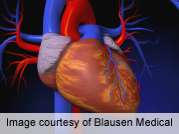(HealthDay)—Nonclinical factors account for considerable variation in the detection of obstructive coronary artery disease (CAD) with coronary angiogram, according to a study published online Sept. 2 in Circulation: Cardiovascular Quality & Outcomes.
Harindra C. Wijeysundera, M.D., Ph.D., from the University of Toronto in Canada, and colleagues evaluated data from all patients in Ontario, Canada who underwent coronary angiography for possible suspected stable ischemic heart disease from Oct. 1, 2008 to Sept. 30, 2011. The incremental impact of nonclinical factors on variation in detection of obstructive CAD was assessed, with physician self-referral for angiography, physician type (invasive or interventional), and hospital type examined as the nonclinical factors of interest.
The researchers found that 52 percent of the 60,986 patients had obstructive CAD, with significant range across hospitals (37.3 to 69.2 percent). Fewer cases of obstructive CAD were seen in self-referral versus nonself-referral patients (49.8 versus 53.5 percent; odds ratio [OR], 0.89; P< 0.001). There was also a lower likelihood of obstructive CAD for angiograms performed by invasive physicians versus interventional physicians (48.2 versus 56.9 percent; OR, 0.85; P < 0.001). Obstructive CAD was seen in fewer angiograms performed at diagnostic only centers versus full service centers (42.0 versus 55.1 percent; OR, 0.62; P = 0.04). Nonclinical factors explained 23.8 percent of between-hospital variation.
"Physician and system factors are important predictors of obstructive CAD with coronary angiography," conclude the authors.
More information:
Abstract
Full Text (subscription or payment may be required)
Copyright © 2014 HealthDay. All rights reserved.





















